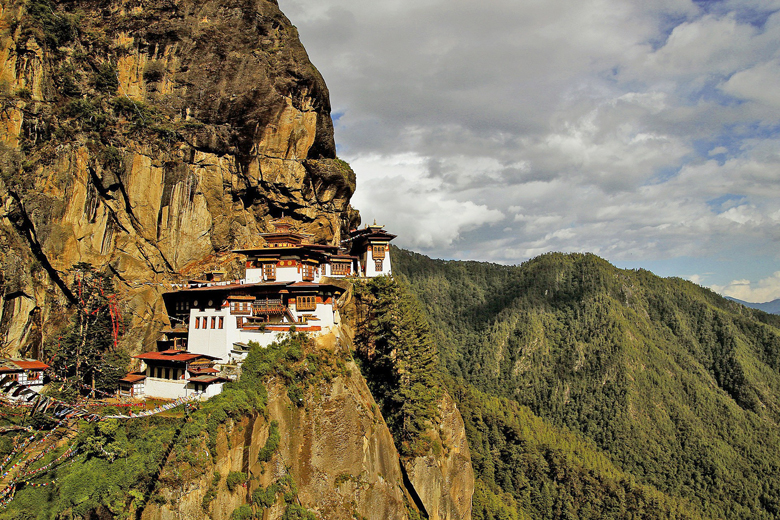Taktsang (Tiger’s Nest) Monastery is a most famous Buddhist monastery complex in Bhutan. It is located on a cliff at 3120 masl -700 meters to the bottom of the valley. The name means Tiger’s Nest. The monastery is an important sacred place for Himalayan Buddhism and includes seven temples.
This temple complex was first built in 1692, around the cave of Taktsang Senge Samdup where Guru Padmasambhava is said to have meditated for three years, three months, three weeks, three days and three hours in the 8th century. Padmasambhava is known as a propagator of Buddhism to the people of Bhutan and the patron deities of the land. At present, Paro Taktsang is very well known because of the thirteen taktsang cave or “tiger nest” where it meditates.
The monastery complex is huge. The main buildings are next to small chapels and elaborately decorated houses. In each of these constructions we will find a sacred image, a unique place for relaxation and meditation. Always with golden images of Guru Rinpoche and its different manifestations.
The temple dedicated to Padmasambhava – also known as Gu-ru mTshan-brgyad Lhakhang, “The Temple of the Eight-Name Master” is an elegant structure built around the cave in 1692 by Gyalse Tenzin Rabgye. This temple has become a cultural icon of Bhutan.
legends : There are several legends about Taktshang, which also explain the unusual name “Tiger nest”. So it is believed that Guru Padmasambhava fled there on the back of a tiger and that he would have tamed the tiger.
Another legend is about Tenzin Rabgye, the builder of the monastery in 1692. It is said that Guru Padmasambhava has been reborn in the form of Tenzin Rabgye and that he has performed various miracles.
Another legend is about Tenzin Rabgye, the builder of the monastery in 1692. It is said that Guru Padmasambhava has been reborn in the form of Tenzin Rabgye and that he has performed various miracles.
The Monastery has become an exceptional tourist destination. is located about 10 km north of the town of Paro on a steep cliff about 900 m above the valley floor. The buildings stand directly on the almost vertical rock noses. Clouds often wrap around the mountain wall, creating a mystical mood. The monastery can only be reached on foot, walking shoes are recommended and you should be free from giddiness. You can also master the majority of the way by mule or horse.
There are about 800 meters to overcome, it should take about 3 hours walking time for the ascent. On the way you pass a prayer wheel powered by a waterwheel. It is said that the water is blessed by contact with the mill. Later you come to the Urgyan Tsemo Monastery, which is also built on a rocky outcrop. There is a cafeteria where you can rest and enjoy the view of the Taktshang Monastery. The mules can not continue from here, so that the rest of the way can only be done on foot. This part of the way is considered scenic.
Access : Coordinates: 27.491911, 89.363489 / Tiger’s Nest is located about 10 km north of the town of Paro. Access to the monastery is on foot or by donkey , mule or horse .The climb takes about three hours, depending on your pace and fitness and the stops you make to take pictures or contemplate the stunning views.
By car :
You can hire a taxi from Thimphu and reach Paro in about 45 minutes
Tips : Camera and Photography is not allowed inside the monastery / Entering the monastery you must deposit your bags and cameras and have to register with the security.
Visiting hours: 8 AM to 1 PM and 2-5 PM daily, October – March / Until 6 PM, April – September.
Events : A popular celebration, known as Tsechu and held in honor of Padmasambhava, is celebrated in the Paro valley around March or April.
Go next : Thimphu – Capital of Bhutan / Taktsang Palphug Monastery / Punakha / Rinpung Dzong / Drukgyel Dzong fortress / Drakhapo / Chumbu Monastery

